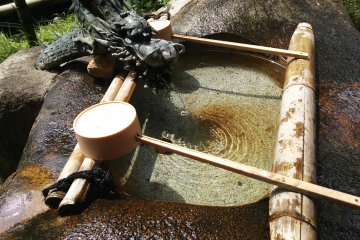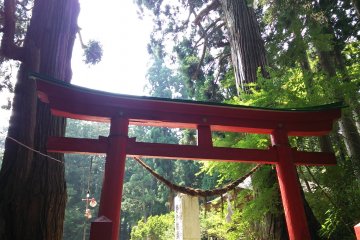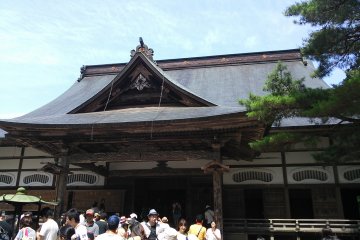Hiraizumi is a beautiful, rural town in southern Iwate and makes for a spectacular introduction to both Tohoku and historical Japan. As the first site in Tohoku to be awarded World Heritage status in 2011, Hiraizumi is an essential stop on any itinerary travelling north of Tokyo. Whilst many temples, gardens and archaeological sites in the area contribute to its global status, Chūson-ji temple is perhaps the most well-known and certainly the best place to start.
The journey to the heart of Chūson-ji is an experience in itself. Arriving at the southern entrance, with dense forest beckoning and cicadas chirping away in the midday heat, the approach path is a steep climb into the heart of the complex atop Mount Kanzan - great training for Tokyo 2020 if you’re feeling inspired! The forest canopy provides cool shelter from the summer heat (or protection from the elements depending on when you visit) and there are vending machines along the route (you’ll notice they are camouflaged in a natural, wooden finish to reduce the eyesore on the surroundings - definitely a nice touch and a good excuse to try Pocari Sweat).
You can choose to visit Hondō first, the Main Hall, but if you continue north-west, you'll head straight for the famous Konjikidō, or Golden Hall. This is a spectacular mausoleum built from wood and covered in golden leaf - an artistic masterpiece as much as an architectural one. It is the same original structure completed in 1123 and is a sight to behold. Around the corner as you leave Konjikidō, you’ll come across the only other original surviving structure at this complex: the Sutra Repository. Whilst it can’t compete with Konjikidō for grandeur, you’ll get a better sense of the age of these structures and appreciate the history of the area. From here, it’s best to continue exploring the grounds in a clockwise direction in order to take in all the sites and views. Just north of the Sutra Repository, at the top of Mount Kanzan, is a great little restaurant called Kanzan-tei. Not just an ideal place to eat and rest, it offers spectacular views across the east of Hiraizumi so is worth visiting on a clear day. You’ll also come across the Hakusan shrine in this area, which is said to be the first structure built here, as well as an outdoor Noh stage. If you visit during the Spring or Autumn Fujiwara Festivals (1st-5th May and 1st-3rd November), you’ll be lucky enough to see live Noh performances too.
What makes Chūson-ji a special experience is not just the history, but the ideal proximity of all the sites, the spectacular views and the short climb up Mount Kanzan making you earn your chance to see the Buddhist temples, not to mention the myriad stalls and shops that serve to improve the experience but never clutter the historical sites and pathways like some tourist sites.
It costs ¥800 to enter Konjiki-dō (Golden Hall), the rest of the grounds and sites are free to explore at your leisure.










